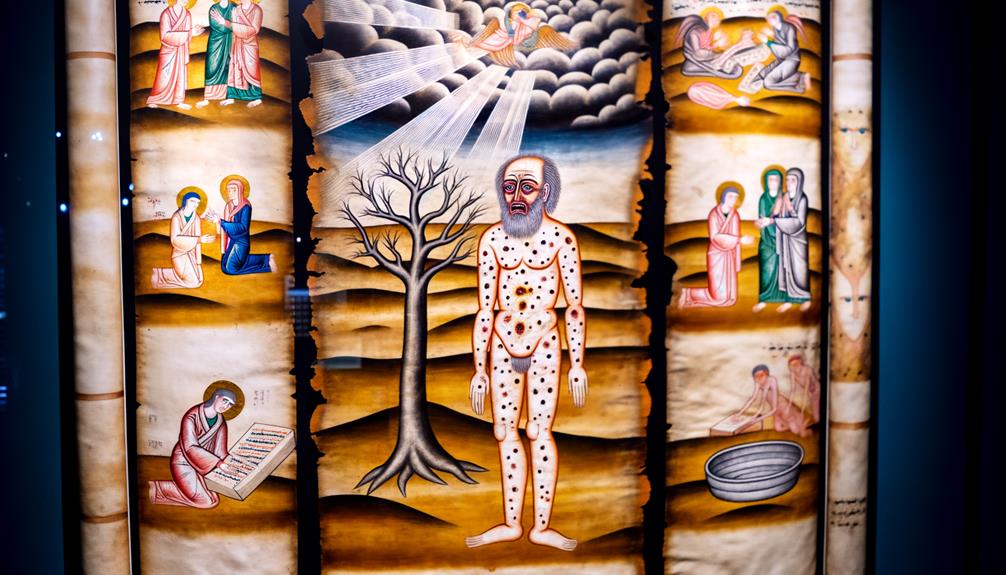Symbolic Meaning of Leprosy in the Bible: Sin, Restoration
In the Bible, leprosy symbolically represents divine judgment, moral corruption, and the challenge of maintaining purity. Instances such as Miriam’s punishment, Gehazi’s greed, and King Uzziah’s pride showcase its role as divine retribution for moral failings.
Symbolically, leprosy illustrates the pervasive corruption of sin, visible both physically and spiritually. It underscores ancient rituals of purification and the socio-religious need to restore the individual’s holiness.
Through the actions of priests and narratives of miraculous healing, leprosy highlights God’s ability to cleanse and redeem. Exploring these narratives uncovers deeper insights into the spiritual lessons conveyed through this affliction.

Symbolic Meaning of Leprosy in the Bible: Sin, Spiritual Impurity, and Divine Healing
| Aspect | Biblical Meaning |
|---|---|
| Sin & Spiritual Impurity | Leprosy is often used as a symbol of sin, impurity, and spiritual uncleanness. Just as leprosy isolates and defiles, sin separates individuals from God and makes them spiritually unclean (Leviticus 13:44-46). |
| Judgment & Consequences | In the Bible, leprosy is sometimes depicted as a consequence of disobedience, pride, or rebellion against God, serving as a visible sign of divine judgment (2 Kings 5:27, Numbers 12:10). |
| Need for Cleansing & Redemption | The detailed process for cleansing leprosy in Leviticus symbolizes the need for spiritual cleansing and redemption, showing that only God can restore purity (Leviticus 14:1-7). |
| Isolation & Separation | Leprosy, which required individuals to live outside the camp, symbolizes the isolation caused by sin, emphasizing the need for reconciliation and healing (Leviticus 13:45-46). |
| Healing & Restoration | Jesus’ healing of lepers highlights His power to cleanse and restore, showing that God’s grace can overcome sin and bring complete spiritual healing (Matthew 8:2-3, Luke 17:12-14). |
Leprosy as Divine Judgment
In biblical narratives, leprosy is frequently depicted as a manifestation of divine judgment, serving as both a physical ailment and a symbolic representation of spiritual and moral transgression. This view is grounded in historical accounts, such as the affliction of Miriam in Numbers 12:10, which illustrates the immediate consequence of her rebellion against divine authority.
Theologically, leprosy in these texts underscores the gravity of disobedience to God’s commandments, positioning the affliction as an instrument of divine correction.
Leviticus 13-14 further codifies the regulations for diagnosing and purifying leprosy, embedding the disease within the ritualistic framework of Israelite society.
This integration of physical illness with spiritual doctrine reflects the ancient understanding of health and holiness as intertwined dimensions of human existence.
Symbolism of Sin and Corruption

Leprosy in the biblical context transcends its physical manifestations, encapsulating the pervasive and insidious nature of sin and moral decay within the community of believers. Historically, leprosy was viewed not merely as a physical ailment but as a spiritual metaphor for the corrosive effects of sin. Theologically, it symbolized the deep-seated corruption that can infiltrate and defile the human soul, leading to social and spiritual isolation.
| Aspect | Leprosy | Sin and Corruption |
|---|---|---|
| Physical Manifestation | Visible skin lesions | Observable immoral actions |
| Social Consequence | Isolation from the community | Alienation from God and fellow believers |
| Spiritual Implication | Considered unclean and cursed by God | Moral decay and separation from divine grace |
This symbolism served to highlight the need for divine intervention and personal repentance.
Leprosy and Ceremonial Purity

In biblical times, leprosy was intricately linked with concepts of ceremonial purity, necessitating specific ritual cleansing practices to restore an individual’s purity and reintegrate them into the community.
These practices, detailed in Leviticus, underscore the symbolic spiritual implications, where the physical affliction of leprosy serves as a representation of deeper spiritual and moral contamination.
This theological perspective reveals how physical health and spiritual sanctity were profoundly interconnected in the ancient Israelite worldview.
Ritual Cleansing Practices
Ancient Israelite rituals for cleansing leprosy, as detailed in the book of Leviticus, underscore the intricate relationship between physical ailment and spiritual purity within the theological framework of the Old Scriptures. These rituals involved a multifaceted process that not only aimed at physical healing but also reinstated the individual into the community, thereby restoring both social and spiritual order.
| Ritual Element | Theological Significance |
|---|---|
| Sacrifice of Birds | Atonement and purification |
| Seven-day Isolation | Period of spiritual introspection |
| Anointing with Oil | Symbol of divine blessing |
These practices highlight the holistic approach of ancient Israelite religion, where physical and spiritual states were intertwined, reflecting an all-encompassing worldview that sought to maintain communal sanctity.
Symbolic Spiritual Implications
The affliction of leprosy in biblical texts serves as a profound metaphor for the spiritual and ceremonial impurity that separates individuals from the divine and the community.
Leprosy’s manifestation symbolizes the pervasive nature of sin and its capacity to corrupt and alienate. The theological implications are significant, as leprosy underscores the necessity of purification rituals to restore holiness and communion with God.
Historically, the isolation of lepers reflects the community’s concerns about maintaining ritual purity.
- Spiritual Alienation: Leprosy represents the distancing from God’s presence.
- Ritual Purity: Emphasizes the importance of cleansing to rejoin the community.
- Symbol of Sin: Illustrates the corrupting influence of sin.
This perspective reveals the deep interconnection between physical ailment and spiritual condition in biblical narratives.
Miriam’s Punishment and Repentance

Amid the desert wanderings of the Israelites, Miriam’s affliction with leprosy serves as a profound theological and symbolic lesson on the consequences of rebellion and the necessity for repentance.
Her challenge to Moses’ unique authority, as recounted in Numbers 12, brought divine retribution in the form of leprosy, marking her physically and spiritually. This punitive measure underscores the sanctity of God’s chosen leadership and the severe repercussions of dissent. Miriam’s seven-day quarantine outside the camp, in accordance with Mosaic law, demonstrates the biblical significance of 347, a number that symbolizes the completion of a cycle or period of affliction and purification. This incident serves as a powerful reminder of the importance of respecting God’s appointed leaders and the consequences of challenging their authority, highlighting the biblical significance of 347 as a marker of spiritual restoration and reconciliation.
Miriam’s subsequent isolation outside the camp for seven days symbolizes purification and communal restoration, resonating with the broader biblical theme of returning to divine favor through repentance.
Her healing, mediated through Moses’ intercession, highlights the interplay between divine justice and mercy, reinforcing the importance of humility and obedience.
Gehazi’s Greed and Consequences

Gehazi’s narrative in 2 Kings 5 serves as a poignant illustration of greed’s costly consequences, where his deceitful pursuit of wealth results in him being stricken with leprosy, symbolizing divine retribution.
Historically, leprosy in the Bible is often portrayed as a manifestation of God’s judgment, reinforcing the gravity of moral failings.
Theologically, Gehazi’s fate underscores the imperative for integrity and the inherent dangers of covetousness, offering profound moral lessons for both ancient and contemporary audiences.
Greed’s Costly Consequences
Frequently overlooked in biblical narratives, the story of Gehazi serves as a poignant illustration of how unchecked greed can lead to devastating spiritual and physical consequences. Gehazi, the servant of the prophet Elisha, succumbed to avarice by deceitfully obtaining gifts from Naaman, a healed leper. This act of greed resulted in severe repercussions, both immediate and enduring.
Key elements of Gehazi’s story include:
- Deception: Gehazi lied to Elisha and Naaman.
- Judgment: Gehazi was cursed with Naaman’s leprosy.
- Moral: The narrative underscores the peril of greed.
Analyzing Gehazi’s fate reveals the profound moral and theological lessons embedded in this biblical account.
Leprosy as Divine Punishment
The account of Gehazi’s punishment with leprosy serves as a stark example of how divine retribution in biblical narratives often intertwines physical affliction with moral failings, particularly in the context of greed.
Gehazi, the servant of the prophet Elisha, succumbed to avarice by deceitfully acquiring gifts from Naaman, despite Elisha’s refusal. Historically, leprosy symbolized not just physical decay but also spiritual and moral corruption.
Theologically, Gehazi’s affliction was a divine chastisement, underscoring the gravity of sin and the sanctity of prophetic instruction. This narrative underscores the biblical principle that divine justice is thorough, addressing both internal moral decay and outward behavior.
Gehazi’s leprosy therefore serves as a cautionary tale of the severe consequences of violating divine mandates.
Moral Lessons From Gehazi
Examining the story of Gehazi reveals profound moral lessons about the perils of greed and the far-reaching consequences of ethical lapses in a theological context.
Gehazi, the servant of Elisha, succumbed to greed by deceitfully acquiring gifts from Naaman, violating his master’s directive. This act led to severe repercussions, as Gehazi was struck with Naaman’s leprosy.
The narrative underscores several key lessons:
- Moral Integrity: Upholding ethical standards even when tempted.
- Divine Retribution: Consequences for moral failings are inevitable.
- Trust and Betrayal: Breach of trust results in personal and communal damage.
Through Gehazi’s story, the Bible illustrates the immutable principle that unchecked greed leads to spiritual and physical affliction.
King Uzziah’s Pride and Fall

How did King Uzziah‘s journey from pious ruler to afflicted outcast illustrate the perilous consequences of pride in the biblical narrative?
Uzziah, initially a righteous and powerful king of Judah, enjoyed prosperity and divine favor due to his commitment to God (2 Chronicles 26:5). However, his burgeoning pride led him to usurp priestly duties by burning incense in the temple, an act reserved solely for priests (2 Chronicles 26:16-18).
This transgression provoked divine wrath, manifesting as leprosy, rendering him ritually impure and permanently exiled from the temple and his royal duties (2 Chronicles 26:19-21). Uzziah’s downfall underscores a theological principle: prideful overreach against divine order invites severe consequences, illustrating the vulnerability of even the most favored individuals to divine judgment.
Leprosy and the Role of Priests

Within the biblical context, priests played a crucial role in diagnosing and managing cases of leprosy, as outlined in Leviticus 13-14, thereby serving as both spiritual leaders and guardians of communal purity. This dual responsibility underscored the theological significance of leprosy as not merely a physical ailment but also a symbol of spiritual impurity.
Key priestly duties included:
- Inspection and Diagnosis: Priests meticulously examined individuals to determine the presence and severity of leprosy.
- Isolation and Re-integration: They enforced quarantine measures and facilitated the return of healed individuals.
- Ritual Cleansing: Priests conducted elaborate purification rituals, including offerings and sacrifices.
This priestly involvement highlighted the intertwining of health and holiness in ancient Israelite society.
Healing and Redemption Narratives

The narratives of healing and redemption in the Bible, particularly those involving leprosy, serve as profound theological metaphors for divine grace and the restoration of both physical and spiritual wholeness.
In the Old Scriptures, the healing of Naaman by Elisha (2 Kings 5) illustrates the inclusivity of God’s mercy, extending beyond Israel to a foreigner.
In the New Scriptures, Jesus’ cleansing of lepers (Matthew 8:1-4, Luke 17:11-19) signifies the Messianic fulfillment of prophecy and the inauguration of the Kingdom of God.
These acts not only demonstrate divine power but also symbolize the breaking of social and religious barriers, offering a holistic redemption that encompasses societal reintegration and spiritual renewal.
These narratives underscore the transformative power of God’s intervention.
Conclusion
The biblical portrayal of leprosy serves as a multifaceted symbol encompassing divine judgment, sin, and ceremonial impurity.
Key narratives, such as those of Miriam, Gehazi, and King Uzziah, illustrate the profound moral and spiritual lessons associated with this affliction.
Priestly roles in diagnosing and declaring healing underscore the religious significance of purity.
Ultimately, the stories of healing and redemption, akin to a spiritual antivirus update, offer a theological perspective on divine mercy and the possibility of restoration.






